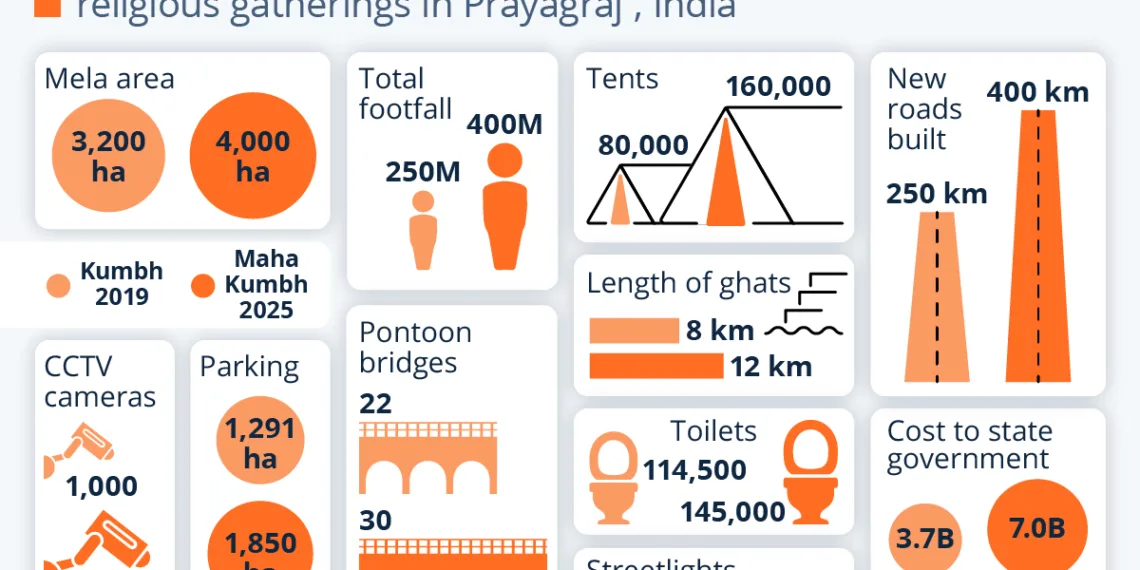Understanding the Maha Kumbh Mela: The World’s Largest Festival
The Maha Kumbh Mela is an extraordinary event that captures the essence of Hindu spirituality and cultural heritage. Often recognized as the world’s largest gathering of human beings, this festival attracts millions of pilgrims who seek spiritual solace and cleansing in the sacred waters of India. Known for its profound significance, the Maha Kumbh Mela stands out not only for its religious importance but also for the logistical complexities involved in organizing such a massive event.
Historical Significance of the Maha Kumbh Mela
The origins of the Kumbh Mela date back centuries, drawing on ancient traditions detailed in Hindu scriptures. Based on astronomical alignments, the festival recurs every 12 years, while a grander version, the Maha Kumbh, occurs every 144 years. This infrequent cycle is determined by specific celestial configurations of Jupiter, the sun, and the moon, believed to enhance the festival’s sanctity.
Location of the Maha Kumbh Mela
The festival rotates among four sacred riverside locations: Prayagraj, Haridwar, Nashik, and Ujjain. Each city holds its unique spiritual significance, with Prayagraj being particularly revered. Situated at the confluence of three holy rivers—the Ganges, Yamuna, and the mythical Sarasvati—Prayagraj is considered a locus where the divine and mortal realms intersect.
A Gathering of Millions: Attendance and Footfall
The magnitude of the Maha Kumbh Mela is staggering. In recent years, the number of attendees has reportedly surged, with estimates indicating that around 400 million pilgrims participated in the latest festival, markedly up from 250 million during the previous smaller “Half Kumbh” celebrated in 2019. This massive influx presents both opportunities for spiritual enrichment and challenges in crowd management and safety.
Logistical Challenges: Infrastructure and Management
Organizing such a mammoth event requires meticulous planning and execution. The Indian authorities, anticipating millions of visitors, have constructed a network of temporary infrastructures, including:
- Tents: Approximately 160,000 tents have been prepared to accommodate the pilgrims.
- Roads and Pathways: Over 400 kilometers of new roads have been developed to facilitate traffic and accessibility, as well as expanded pathways leading to the riverbanks.
- Street Lighting: With 67,000 streetlights planned, organizers aim to ensure safety and visibility at night.
- Water Transport: Thirty pontoons have been set up for pilgrims to safely navigate the riverbanks.
Security Measures and Safety Protocols
Due to the immense scale of the festival, ensuring the safety of attendees is of utmost priority. This year, nearly 40,000 police personnel and security guards were deployed to maintain order during the event. Additionally, the installation of around 2,300 CCTV cameras was implemented to monitor activities and enhance surveillance.
Economic Impact: Rising Costs of Management
The financial implications of the Maha Kumbh Mela extend beyond logistical preparations. The cost burden on the state government has significantly escalated, with expenses projected to rise from 3.7 billion rupees (approximately $43 million) in 2019 to 7 billion rupees (around $81 million) during the 2025 event. This surge reflects not only the growing number of attendees but also the increased investments necessary to ensure safety and infrastructure development.
Religious and Cultural Practices During the Festival
At the heart of the Maha Kumbh Mela lies its primary religious activity: the ritual bathing in sacred rivers. Pilgrims believe that immersing themselves in these hallowed waters can absolve them of sins and deliver spiritual liberation. Beyond the bathing rituals, the festival features numerous religious discourses, cultural performances, and food stalls, adding to its vibrant atmosphere.
Conclusion
The Maha Kumbh Mela is more than just a religious festival; it is a convergence of faith, culture, and communal spirit. The unique blend of unprecedented attendance, intricate logistics, and profound religious significance makes it a fascinating study of human devotion and organization. Whether you seek spiritual fulfillment or cultural immersion, the Maha Kumbh Mela is a monumental event that should be witnessed to truly appreciate its grandeur.












